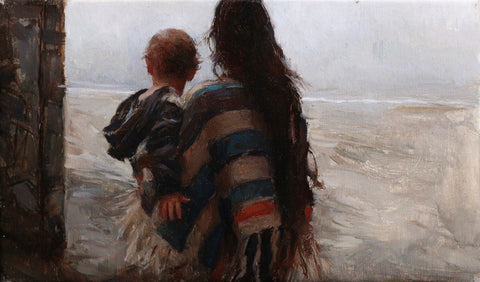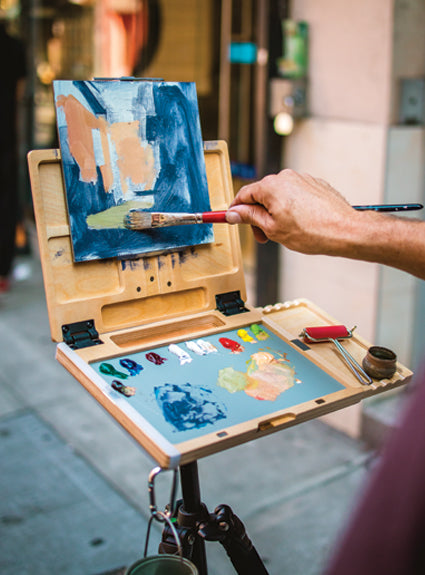INTERVIEW with TIM REES
WHERE DO YOU LIVE AND WORK?
I currently live in Mesa, Arizona. My atelier where I teach and work is located in downtown Mesa.
TELL US ABOUT YOUR PAINTING CAREER.
I began painting in 2009, and a few months later was in my first gallery in downtown Phoenix. The next year I had built up a larger body of work and began showing in Scottsdale, Arizona, then a few years later in Santa Fe, New Mexico, where I currently exhibit through McLarry Gallery. I began teaching drawing and painting in 2011, and in 2014 I wrote and taught a part-time two-year classical training program at the Scottsdale Artists’ School. In 2017 I moved the program to a new 3700 square foot facility and expanded the program to bring in full-time apprentices. This is where I now work and teach.

WHAT IS YOUR EDUCATIONAL BACKGROUND IN THE ARTS?
My only formal education in the arts was one year at an animation school, but as we transitioned from traditional animation to computers I lost interest and left the program. Years later when I began painting, I attended a 3-day figure painting workshop by Jeremy Lipking. Observing him paint, combined with diligent study of Richard Schmid’s book “Alla Prima”, provided the basis for my direction in painting. Later in 2009 I moved to Chicago and became a member of the Palette and Chisel, a club dedicated to painting the model from life that hosts uninstructed open studio sessions every day. I studied for 3 years painting models alla prima at the P&C while completing paintings in my own studio, but eventually felt I hit a limit on what I could learn. I moved back to Arizona, and as an instructor at the Scottsdale Artists’ School began meeting and painting with professional artists from all over the country. This, along with teaching a formally structured program, brought my understanding of painting to the next level.
WHAT IS A LITTLE KNOWN FACT YOU WOULD LIKE TO SHARE ABOUT YOURSELF?
My 3 year old son and I are huge fans of all things related to space and Star Trek. We play with his Star Trek Next Generation action figures almost every day. I personally find my impression of Patrick Stewart to be top notch… at least to a 3-year-old.

YOU ARE A SELF TAUGHT ARTIST. HOW HAS YOUR PATH HELPED MOLD YOUR APPROACH TO PAINTING?
The two living artists I first stumbled onto that were dazzling enough to pull me into the world of painting were firm promoters of observational painting; squint, observe, and paint what you see. This was the theme running through “Alla Prima”, and it was the answer given to me when I asked Jeremy Lipking how he had painted some rather impressive white fur. This methodology became my guiding principle for a couple years. Whenever something did not come out well, I admitted it was probably because I was not observing correctly, and I should refine my observation more. This practice set me up to have highly developed observational skills before I dug deeply into a variety of techniques and concepts about light, anatomy, perspective, etc.

YOU WERE ABLE TO FIND GAPS IN YOUR OWN PRACTICES WHILE STUDYING ON YOUR OWN. CAN YOU TAKE US DOWN THIS PATH? While honing my ability to paint from observation, I obsessively studied on my own, looking to many sources to answer questions I’ve had. It started with one book (“Alla Prima”), and grew to countless other books, both contemporary and historical. I remember hours upon hours in the evenings plowing through old texts with flowery language, highlighter in hand, picking out anything related to the technical craft of painting. I picked up high quality magazines whenever I could, cutting out the best articles with the clearest images and putting them into a binder, studying the edges and colors of paintings with a magnifying glass on breaks from painting the model. Everything was a technical problem that needed to be solved, and my mentality was, “If some other human did it, it means I should be able to do it also, I just need to figure out how.” It was a strong curiosity and a scientific approach that has lead me down a path of exploring and unlocking different techniques.
I began to write quite a bit about how to paint. I used this to identify gaps in my understanding of painting. The more clearly one understands something, the more directly they can describe it. For me, teaching and writing became a path to my greater understanding. As my understanding of different techniques grew, so did the volume and range of my writing and the videos that I began to put out. Last year I released the Classical Drawing Bundle and the Classical Painting Bundle; an expansive and comprehensive digital course cataloging the atelier approach.
Ultimately, as I studied more and more, I was unknowingly thrust away from a traditional atelier mentality of painting things one way. Rather than thinking there was a best way for doing everything, I sought out the best way to approach each individual situation. I wanted to be able to paint something successfully in 20 minutes or 200 hours; to paint sunsets or baroquely lit models; to have glass-like paint films, or those broken and loose. Now, after a decade of fierce study, I take these skill sets and adapt them to my circumstance and my vision. I will use multiple techniques in a single work to achieve greater illusion of depth, to direct the viewer’s focus, or to just give the viewer a visual feast.
LETS LOOK AT TWO OF YOUR PAINTINGS: 'JUNE'S VIVIFICATION' AND 'THE BRIBE.' CAN YOU TAKE US THROUGH SOME OF THE TECHNIQUES USED IN EACH?

June’s Vivification (commonly called my Blue Dress painting), is a life-size, seven-foot-tall painting of a young woman in a blue dress reaching out to a swirl of flowers. In most reproductions, the face and figure appear soft and blended while the surrounding elements dissipate into abstraction. In reality, not much in the painting is blended at all. The technique used that best describes it is tiling (laying down pieces of paint next to each other). The pieces of paint on the face and figure are right next to each other, and the color/value transitions are carefully mixed, so the face looks very smooth with little to no blending. The further from the face and figure, the farther apart the tiles and bigger the brush, creating a looser look. This technique relies on careful observation and delicate color mixing, and ultimately helps shift the perception of the painting toward its aesthetic, rather than to specifically elevate the narrative.

'The Bribe', however, incorporates a variety of techniques for a variety of different purposes. The depth of the scene is broken into four fields (like the depth of field of a camera). The paint application is significantly more open with thin paint films used in the closest and furthest fields, while the two middle fields (incorporating the figures) are painted more solidly with layered paint built up and textured. This is a subtle use of technique that, while viewing the painting in person, can have an influence on what is believed to be “more in focus”. This was a technique that some naturalist painters, like Emile Friant, used to help establish greater depth of field. The parts in much greater focus, like the belly of the mother, are built up with multiple layers, utilizing a special paint (stack lead white) to create Rembrandt-like textural paint buildup suggesting greater volume. This is also used to create interesting elements like stretch marks. To boost the color beyond the limits of body paint, even glazing was used in the top right to shift and enhance the color of the lamp while keeping the value very light. Overall, the tricky part is integrating techniques that were developed over the span of 450 years into a painting without them looking out of place or distracting. One area that viewers can look to in this particular painting is the orange stuffed animal on the book case. As the foreshortening pushes it from the third field of depth to the fourth, the paint application moves from impasto to become loose and broken.

YOU'VE DESCRIBED YOUR TEACHING DVD'S AS THE MOST COMPREHENSIVE DIGITAL COURSES CATALOGING THE ATELIER APPROACH. CAN YOU EXPLAIN THIS A BIT FURTHER?
When my atelier class structure was very rigid (and some classes would only come once per year), I started filming the lectures and demonstrations for students that had to miss class for whatever reason. Over time, visitors to the studio continued to express interest in the videos and to encourage me to offer them to the public. I then embarked on a two-year project to film, narrate, and organize all the videos to be understood by someone not enrolled in the atelier, wanting to pursue a classical education in a structured format. I wrote two textbooks (one to accompany the drawing videos, and one for the painting videos), that are information-dense and include demonstrations, curriculums, and workbooks. We put these into a box set with a high-resolution catalog of prints (from the demonstrations), and released them as the Classical Drawing Bundle and the Classical Painting Bundle.
Not only do the bundles include 45 demonstrations, 32 lectures, and 44 assignment introductions detailing the curriculum of a traditional atelier, I also used the painting videos as an opportunity to describe the variety of techniques I have studied and utilize in my painting. Instead of 23 videos showing the same way to paint something, they explore glazing, direct painting, scraping and layering, and more. The textbook acts as a step-by-step guide for the videos and includes over a dozen more step-by-steps. Collectively, the Classical Drawing Bundle and the Classical Painting Bundle represent the most comprehensive, organized, representational virtual art school.

WHAT ARE YOUR "GO TO" ART SUPPLIES?
I have to admit, my large u.go Pochade Box is amazing. I have even started to use it inside the studio as well as traveling. I like to use my tripod to get the palette right in front of the area I’m painting when working on larger pieces (and I usually put my color study on the panel mount). I’ve been using it for almost a year now, and it has stood up to daily abuse like a champ. I love how insanely light it is, and the magnets are awesome (adjusting the canvas holder is so much easier than boxes I’ve used in the past). My favorite part might be the palette that slides in and out for cleaning, but it’s hard to pick- I like all the features. I guess I’m just a sucker for good design.
I prefer Rosemary Brushes to paint with – they are super well-built and they have a few brushes (like the extra-long comber) that are wonder brushes that seem to do everything to achieve a variety of marks.
The paints I’m in love with are by Michael Harding. They have no filler, have amazing tint power, seem to last forever before a tube runs out, and include a mind-boggling gorgeous range of color.
I’ve been using Artefex panels lately. They use aluminum composite panels to mount their linen to, which I love for its durability and resistance to warping.

-Tim Rees
www.reesfineart.com












